Abstract
Interleukin 2 (IL-2)-mediated signaling through its high-affinity receptor involves a complex interrelationship between IL-2 and two IL-2-binding chains, IL-2R alpha and beta chains. Previously with the reagents available it was difficult to define functional interactions between these two IL-2R subunits involved in IL-2 binding and signal transduction. To extend our understanding of the interplay between the two binding subunits we have done studies with the monoclonal antibody HIEI, which interferes with interaction of IL-2R alpha and beta chains (IL-2R alpha and IL-2R beta, respectively). Furthermore, we used two forms of IL-2, recombinant native IL-2 and F42A, an IL-2 analog (Phe-42----Ala substitution) that binds only to IL-2R beta. Analog F42A manifested 75-100% of the bioactivity of wild-type IL-2. This observation is inconsistent with the strict hierarchical IL-2-binding affinity conversion model previously proposed by Saito and coworkers [Saito Y., Sabe, H., Suzuki, N., Kondo, S., Ogura, T., Shimizu, A. & Honjo, T. (1988) J. Exp. Med. 168, 1563-1572] that predicted an ordered sequence of events in which IL-2 must first bind to IL-2R alpha before its interaction with IL-2R beta. Previous investigations using IL-2 variants were interpreted to show that IL-2R alpha merely acts to concentrate IL-2 to the cell surface and that no other meaningful interaction occurred between IL-2R alpha and IL-2R beta. However, our data are inconsistent with this view. We draw this conclusion on the basis of our observation that antibody HIEI, which reacts with an epitope of IL-2R alpha and interferes with interaction of this chain and IL-2R beta, inhibits the IL-2-dependent proliferative effects mediated by analog F42A. Furthermore, by blocking interaction of IL-2R alpha and IL-2R beta with the antibody HIEI, a decrease in the affinity of radiolabeled analog F42A for IL-2R beta was seen. In our proposed model IL-2R alpha contributes several functions to IL-2-mediated signaling through the high-affinity IL-2R. These functions include concentration of IL-2 within the two-dimensional surface of the plasma membrane as well as alteration of the functional capacity of IL-2R beta, an effect that does not require prior binding of IL-2R to IL-2R alpha. The IL-2R alpha-mediated augmentation of IL-2R beta functions involves affinity conversion of IL-2R beta, increasing its affinity for IL-2, and may involve facilitation of Il-2-mediated signaling after binding of IL-2 to this IL-2R beta.
Full text
PDF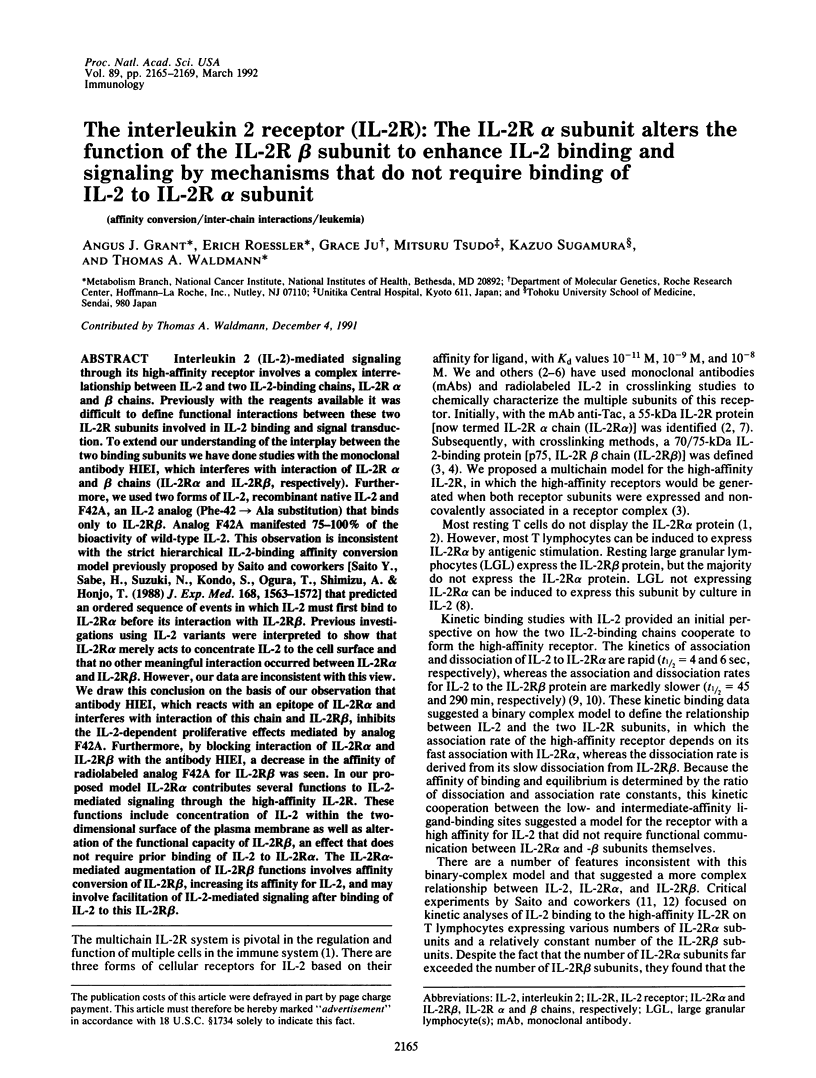
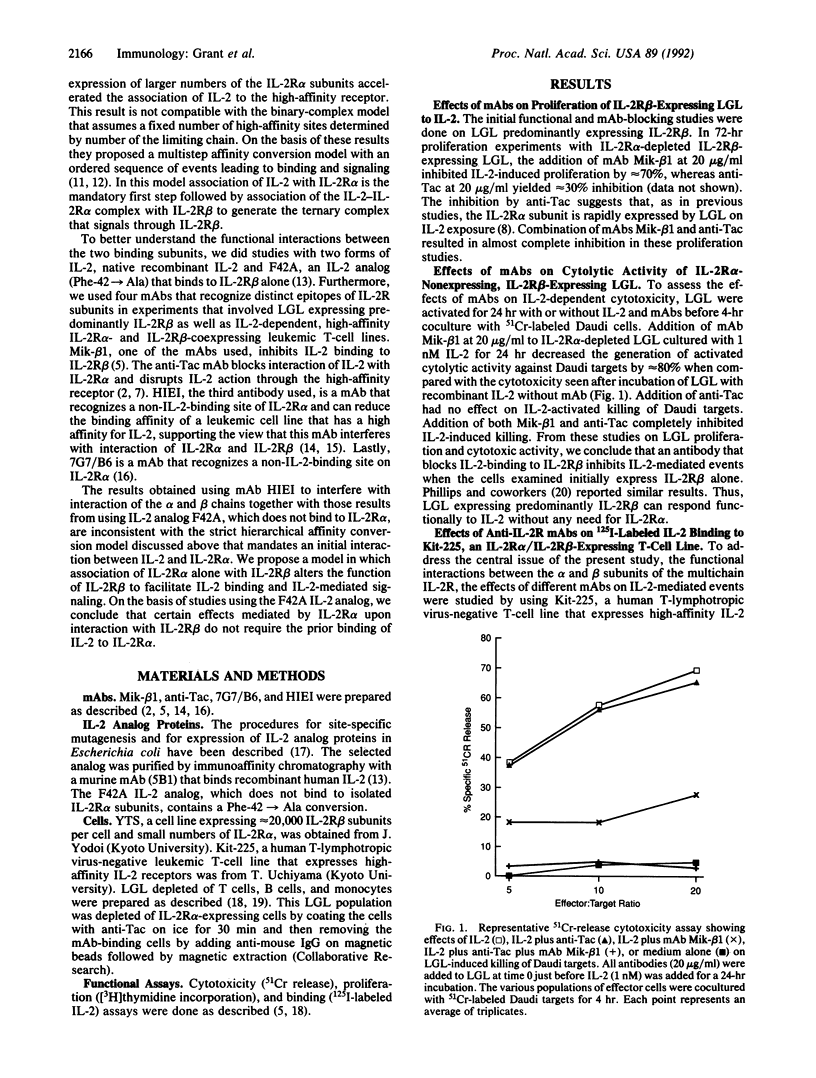
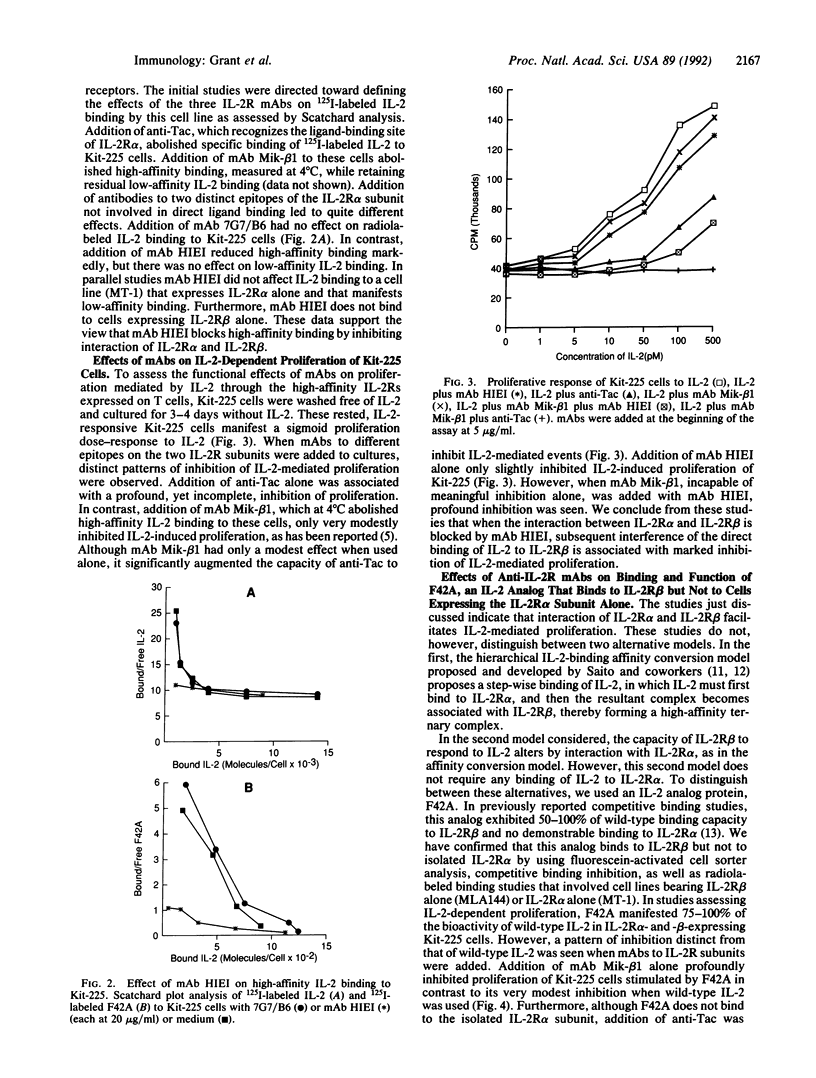
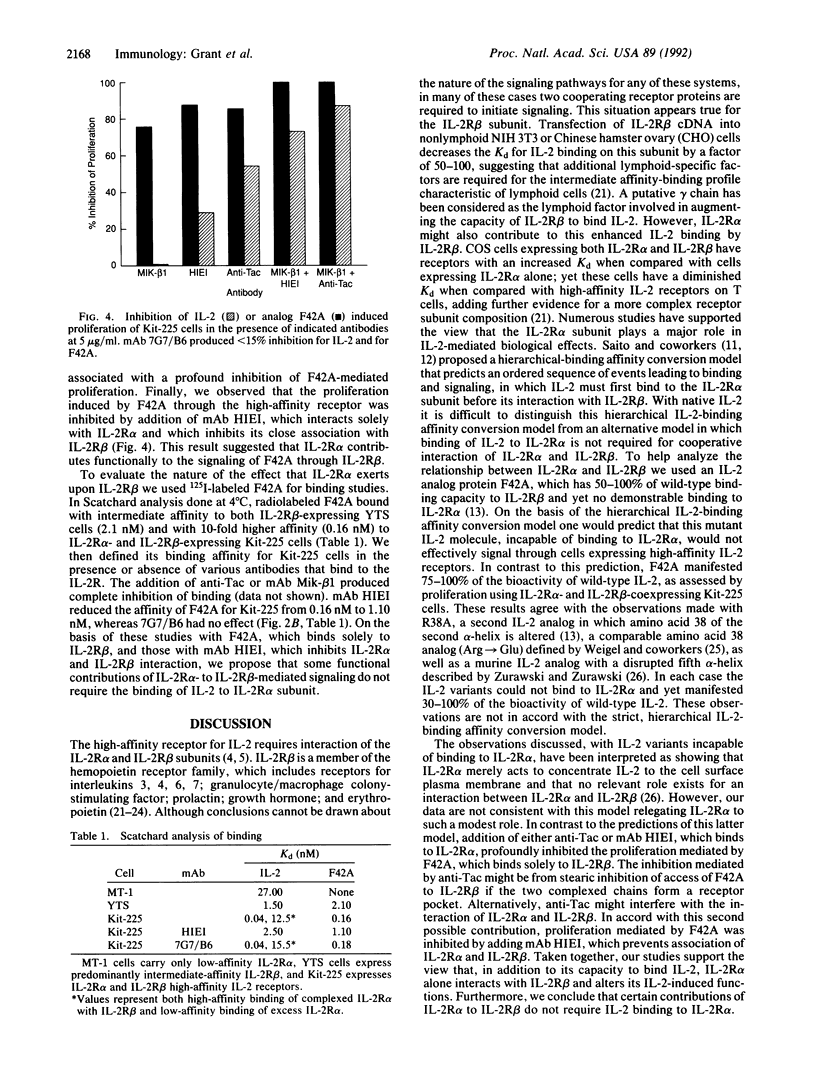
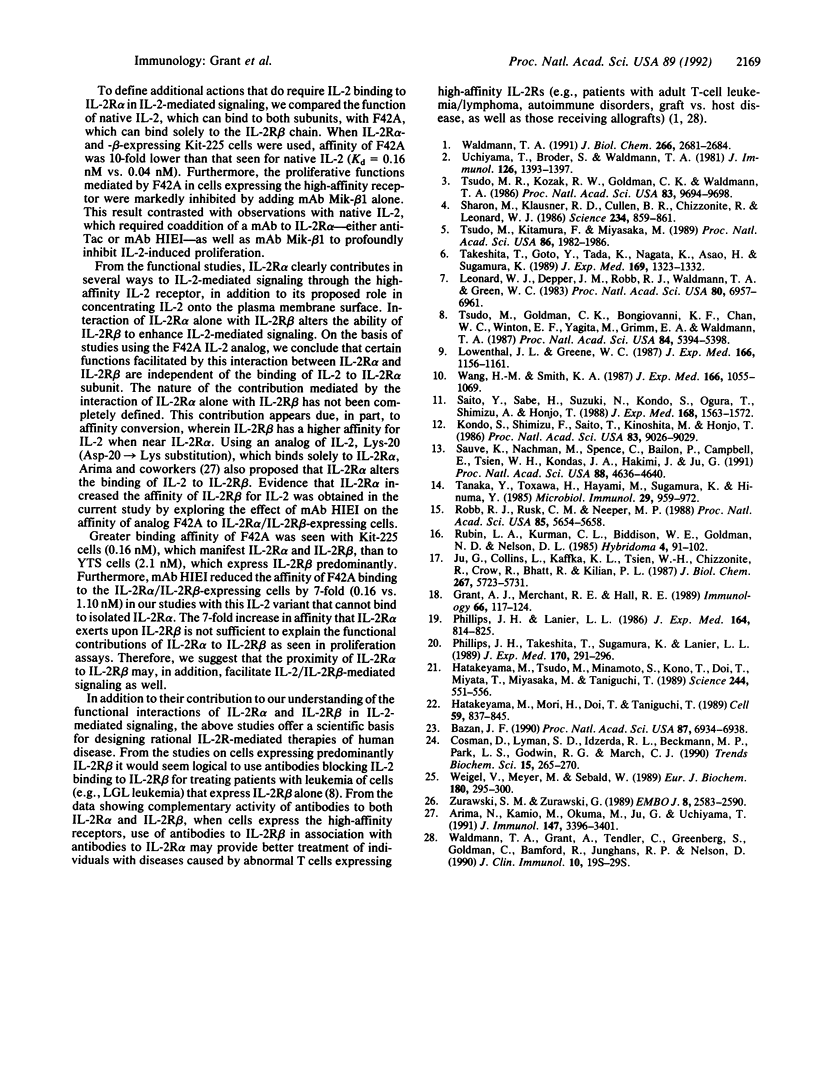
Selected References
These references are in PubMed. This may not be the complete list of references from this article.
- Arima N., Kamio M., Okuma M., Ju G., Uchiyama T. The IL-2 receptor alpha-chain alters the binding of IL-2 to the beta-chain. J Immunol. 1991 Nov 15;147(10):3396–3401. [PubMed] [Google Scholar]
- Bazan J. F. Structural design and molecular evolution of a cytokine receptor superfamily. Proc Natl Acad Sci U S A. 1990 Sep;87(18):6934–6938. doi: 10.1073/pnas.87.18.6934. [DOI] [PMC free article] [PubMed] [Google Scholar]
- Cosman D., Lyman S. D., Idzerda R. L., Beckmann M. P., Park L. S., Goodwin R. G., March C. J. A new cytokine receptor superfamily. Trends Biochem Sci. 1990 Jul;15(7):265–270. doi: 10.1016/0968-0004(90)90051-c. [DOI] [PubMed] [Google Scholar]
- Grant A. J., Merchant R. E., Hall R. E. Interleukin-2 modulates the expression of lymphocyte function-associated antigen-one (LFA-1) and p150,95 during the generation of lymphokine-activated killer (LAK) cells. Immunology. 1989 Jan;66(1):117–124. [PMC free article] [PubMed] [Google Scholar]
- Hatakeyama M., Mori H., Doi T., Taniguchi T. A restricted cytoplasmic region of IL-2 receptor beta chain is essential for growth signal transduction but not for ligand binding and internalization. Cell. 1989 Dec 1;59(5):837–845. doi: 10.1016/0092-8674(89)90607-7. [DOI] [PubMed] [Google Scholar]
- Hatakeyama M., Tsudo M., Minamoto S., Kono T., Doi T., Miyata T., Miyasaka M., Taniguchi T. Interleukin-2 receptor beta chain gene: generation of three receptor forms by cloned human alpha and beta chain cDNA's. Science. 1989 May 5;244(4904):551–556. doi: 10.1126/science.2785715. [DOI] [PubMed] [Google Scholar]
- Ju G., Collins L., Kaffka K. L., Tsien W. H., Chizzonite R., Crowl R., Bhatt R., Kilian P. L. Structure-function analysis of human interleukin-2. Identification of amino acid residues required for biological activity. J Biol Chem. 1987 Apr 25;262(12):5723–5731. [PubMed] [Google Scholar]
- Kondo S., Shimizu A., Saito Y., Kinoshita M., Honjo T. Molecular basis for two different affinity states of the interleukin 2 receptor: affinity conversion model. Proc Natl Acad Sci U S A. 1986 Dec;83(23):9026–9029. doi: 10.1073/pnas.83.23.9026. [DOI] [PMC free article] [PubMed] [Google Scholar]
- Leonard W. J., Depper J. M., Robb R. J., Waldmann T. A., Greene W. C. Characterization of the human receptor for T-cell growth factor. Proc Natl Acad Sci U S A. 1983 Nov;80(22):6957–6961. doi: 10.1073/pnas.80.22.6957. [DOI] [PMC free article] [PubMed] [Google Scholar]
- Lowenthal J. W., Greene W. C. Contrasting interleukin 2 binding properties of the alpha (p55) and beta (p70) protein subunits of the human high-affinity interleukin 2 receptor. J Exp Med. 1987 Oct 1;166(4):1156–1161. doi: 10.1084/jem.166.4.1156. [DOI] [PMC free article] [PubMed] [Google Scholar]
- Phillips J. H., Lanier L. L. Dissection of the lymphokine-activated killer phenomenon. Relative contribution of peripheral blood natural killer cells and T lymphocytes to cytolysis. J Exp Med. 1986 Sep 1;164(3):814–825. doi: 10.1084/jem.164.3.814. [DOI] [PMC free article] [PubMed] [Google Scholar]
- Phillips J. H., Takeshita T., Sugamura K., Lanier L. L. Activation of natural killer cells via the p75 interleukin 2 receptor. J Exp Med. 1989 Jul 1;170(1):291–296. doi: 10.1084/jem.170.1.291. [DOI] [PMC free article] [PubMed] [Google Scholar]
- Robb R. J., Rusk C. M., Neeper M. P. Structure-function relationships for the interleukin 2 receptor: location of ligand and antibody binding sites on the Tac receptor chain by mutational analysis. Proc Natl Acad Sci U S A. 1988 Aug;85(15):5654–5658. doi: 10.1073/pnas.85.15.5654. [DOI] [PMC free article] [PubMed] [Google Scholar]
- Rubin L. A., Kurman C. C., Biddison W. E., Goldman N. D., Nelson D. L. A monoclonal antibody 7G7/B6, binds to an epitope on the human interleukin-2 (IL-2) receptor that is distinct from that recognized by IL-2 or anti-Tac. Hybridoma. 1985 Summer;4(2):91–102. doi: 10.1089/hyb.1985.4.91. [DOI] [PubMed] [Google Scholar]
- Saito Y., Sabe H., Suzuki N., Kondo S., Ogura T., Shimizu A., Honjo T. A larger number of L chains (Tac) enhance the association rate of interleukin 2 to the high affinity site of the interleukin 2 receptor. J Exp Med. 1988 Nov 1;168(5):1563–1572. doi: 10.1084/jem.168.5.1563. [DOI] [PMC free article] [PubMed] [Google Scholar]
- Sauvé K., Nachman M., Spence C., Bailon P., Campbell E., Tsien W. H., Kondas J. A., Hakimi J., Ju G. Localization in human interleukin 2 of the binding site to the alpha chain (p55) of the interleukin 2 receptor. Proc Natl Acad Sci U S A. 1991 Jun 1;88(11):4636–4640. doi: 10.1073/pnas.88.11.4636. [DOI] [PMC free article] [PubMed] [Google Scholar]
- Sharon M., Klausner R. D., Cullen B. R., Chizzonite R., Leonard W. J. Novel interleukin-2 receptor subunit detected by cross-linking under high-affinity conditions. Science. 1986 Nov 14;234(4778):859–863. doi: 10.1126/science.3095922. [DOI] [PubMed] [Google Scholar]
- Takeshita T., Goto Y., Tada K., Nagata K., Asao H., Sugamura K. Monoclonal antibody defining a molecule possibly identical to the p75 subunit of interleukin 2 receptor. J Exp Med. 1989 Apr 1;169(4):1323–1332. doi: 10.1084/jem.169.4.1323. [DOI] [PMC free article] [PubMed] [Google Scholar]
- Tanaka Y., Tozawa H., Hayami M., Sugamura K., Hinuma Y. Distinct reactivities of four monoclonal antibodies with human interleukin 2 receptor. Microbiol Immunol. 1985;29(10):959–972. doi: 10.1111/j.1348-0421.1985.tb02960.x. [DOI] [PubMed] [Google Scholar]
- Tsudo M., Goldman C. K., Bongiovanni K. F., Chan W. C., Winton E. F., Yagita M., Grimm E. A., Waldmann T. A. The p75 peptide is the receptor for interleukin 2 expressed on large granular lymphocytes and is responsible for the interleukin 2 activation of these cells. Proc Natl Acad Sci U S A. 1987 Aug;84(15):5394–5398. doi: 10.1073/pnas.84.15.5394. [DOI] [PMC free article] [PubMed] [Google Scholar]
- Tsudo M., Kitamura F., Miyasaka M. Characterization of the interleukin 2 receptor beta chain using three distinct monoclonal antibodies. Proc Natl Acad Sci U S A. 1989 Mar;86(6):1982–1986. doi: 10.1073/pnas.86.6.1982. [DOI] [PMC free article] [PubMed] [Google Scholar]
- Tsudo M., Kozak R. W., Goldman C. K., Waldmann T. A. Demonstration of a non-Tac peptide that binds interleukin 2: a potential participant in a multichain interleukin 2 receptor complex. Proc Natl Acad Sci U S A. 1986 Dec;83(24):9694–9698. doi: 10.1073/pnas.83.24.9694. [DOI] [PMC free article] [PubMed] [Google Scholar]
- Uchiyama T., Broder S., Waldmann T. A. A monoclonal antibody (anti-Tac) reactive with activated and functionally mature human T cells. I. Production of anti-Tac monoclonal antibody and distribution of Tac (+) cells. J Immunol. 1981 Apr;126(4):1393–1397. [PubMed] [Google Scholar]
- Waldmann T. A., Grant A., Tendler C., Greenberg S., Goldman C., Bamford R., Junghans R. P., Nelson D. Lymphokine receptor-directed therapy: a model of immune intervention. J Clin Immunol. 1990 Nov;10(6 Suppl):19S–29S. doi: 10.1007/BF00918688. [DOI] [PubMed] [Google Scholar]
- Waldmann T. A. The interleukin-2 receptor. J Biol Chem. 1991 Feb 15;266(5):2681–2684. [PubMed] [Google Scholar]
- Wang H. M., Smith K. A. The interleukin 2 receptor. Functional consequences of its bimolecular structure. J Exp Med. 1987 Oct 1;166(4):1055–1069. doi: 10.1084/jem.166.4.1055. [DOI] [PMC free article] [PubMed] [Google Scholar]
- Weigel U., Meyer M., Sebald W. Mutant proteins of human interleukin 2. Renaturation yield, proliferative activity and receptor binding. Eur J Biochem. 1989 Mar 15;180(2):295–300. doi: 10.1111/j.1432-1033.1989.tb14647.x. [DOI] [PubMed] [Google Scholar]
- Zurawski S. M., Zurawski G. Mouse interleukin-2 structure-function studies: substitutions in the first alpha-helix can specifically inactivate p70 receptor binding and mutations in the fifth alpha-helix can specifically inactivate p55 receptor binding. EMBO J. 1989 Sep;8(9):2583–2590. doi: 10.1002/j.1460-2075.1989.tb08397.x. [DOI] [PMC free article] [PubMed] [Google Scholar]


